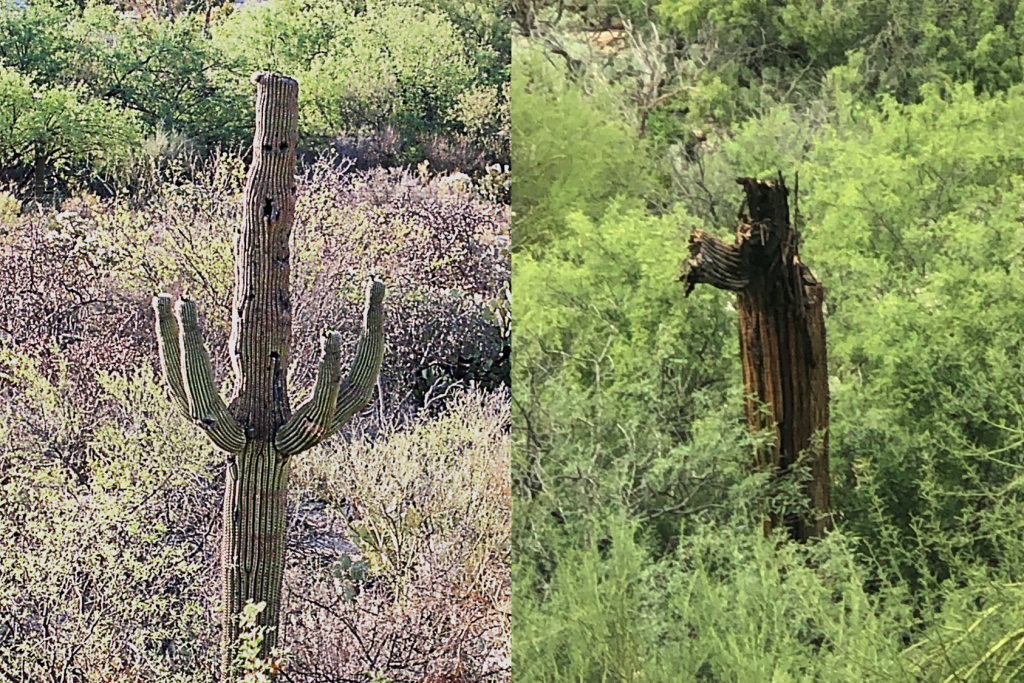On January 21, 1886, Albert Tully was born in Tucson, Arizona. About a week later the first gasoline powered automobile was patented in the United States. Vancouver, British Columbia was established in April of that year. In May, Emile Berliner began work on what would eventually become the gramophone and John Pemberton began to advertise a new beverage: Coca-Cola. That fall, President Cleveland dedicated the Statue of Liberty in New York harbor and Heinrich Hertz verified the existence of electromagnetic waves.
In 1886, in the foothills of the Santa Catalina Mountains north of Tucson, a baby saguaro pushed through the soil and tasted the sun.
There were no houses, resorts or country clubs. There were cattle and cowboys and a sprinkling of ranches. There were the plants and animals of the high desert, saguaros, mesquite and Palo Verde trees, bobcats, coyotes, javelina, roadrunners, quail and rattlesnakes. On occasion, mule deer and mountain lions wandered by.
The baby saguaro was shaded by a Mesquite “nurse tree.” The giant saguaro cactus, famous for its stature and multiple arms, comes into the world as a fragile infant. Most require a nurse tree to protect them from the glaring violence of the sun and the assault of monsoon rains.
In 1900, fourteen-year-old Albert Tully got ahold of some liquor. He drank himself full of courage and rode his horse into a downtown saloon. His father, Charles Hoppin Tully – co-founder of The Arizona Daily Star – fetched him home. The saguaro, still protected by its nurse tree, was barely two inches tall.
Albert Tully passed away in late 1971. By then, the saguaro had outgrown its nurse tree and stood twenty feet above the surrounding desert. It had sprouted what would become four powerful arms, reaching for the sky. Change was taking place. Not far to the north, Skyline Country Club’s new clubhouse dominated the upper foothills. Surveyors trekked the area, platting subdivisions. Roads were bladed. Desert plants, including saguaros, were removed to make way for houses.
The saguaro silently watched the changes take place around it. Birds carved holes for their nests. The nesting holes on its southern exposure resembled a face, with two eyes and a gaping mouth. With its uplifted arms, it seemed to be shouting. Rarely has a silent object been so loud.
In 1977, a young developer named George Mehl built a house uphill from the saguaro. The home was one of several in a new subdivision known as Skyline Belair Estates. The house had a large wooden deck along its north side. The saguaro was the prominent feature in the back yard. The construction did not impact it or its mesquite tree neighbors.
But there was a danger: The County’s plans called for Skyline Drive to be extended eastward from Swan Road to Craycroft. The designated roadway was 150 feet wide, with 75 feet taken from Skyline Belair Estates and the Skyline Country Club Estates to the north. The saguaro was dangerously close to the proposed roadway.
Then came a savior: George Mehl. He and his brother, David, masterminded a foothills development that included the Westin La Paloma Resort, a golf course, commercial development, and residential areas. Sunrise Drive was extended east from Campbell Avenue to Swan. The Skyline Drive extension was no longer needed and the County abandoned the right-of-way in 1980. The saguaro was spared.
A century after Albert Tully – my grandfather — was born, we moved into the house George Mehl built. Our offer was a long shot; my law practice was young and cash flow was sporadic. But when we saw the view from the deck – a sunset view to the west and the Santa Catalina Mountains to the north – we made an offer. My realtor told me later that we were the least qualified buyers the day four offers came in, but the owner chose us because I walked the grounds with him and admired the saguaros.
A few weeks later we moved into the house with its majestic anthropomorphic saguaro that seemed to be waving to us and shouting as we settled in. During our house-warming party a pair of Great Horned Owls danced and circled in the backyard before coming to rest – on the saguaro.
We’ve lived here through many life changes. Our daughter was a toddler who left as a young woman. I was a young man when we bought the house. Kris and I lost our parents and saw beloved dogs come into our lives and leave too early. The saguaro was always there, with its waving arms and gaping mouth. But there were troubling signs.
Several years ago, as an infection was attacking saguaros in the area, our backyard saguaro began to rot at the top. Eventually, it’s upper 18 inches dried up and fell off, leaving the saguaro with a flattop. It grew an appendage that looked like a beret. But the saguaro endured, the monarch of our little kingdom.
But all was not well inside the giant. The infection that cost the monarch its crown apparently remained, slowly weakening the saguaro from within. Two weeks ago, a few days after a vicious monsoon felled our beloved Shoestring Acacia tree, the king silently fell into the surrounding desert. The ancient giant saguaro, born the same year as my grandfather, returned to the mesquite trees where it had been sheltered in its infancy long, long ago.
© 2022 by Mike Tully
<<< YOU CAN READ / DOWNLOAD A PDF VERSION BY CLICKING HERE >>>


Be First to Comment